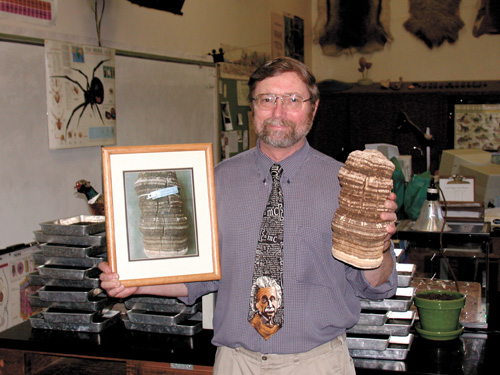Discovering beautiful, edible fungi thrills foragers
Tis the season for Thanksgiving, Christmas … and mushroom forays, but the latter is said to have more in common with Easter, due to the magical hunts that take place during such times.
A foray—which, in terms of mushrooms, essentially refers to a group of people getting together to forage for fungi—offers participants “recreation, exercise, dinner and addiction,” according to Darvin DeShazer, Sonoma County Mycological Association science (SOMA) advisor and one of its founders.
“The thrill is in the hunt,” he said. “It’s similar to an Easter egg hunt. The eggs are not that exciting, but the thrill of finding them is exhilarating.”
The joys of foraging also include “being in the woods, searching for the hidden treasures and walking in beautiful nature,” he said, noting, however, it can be done anywhere, on any walk, even in a city.
Mushrooms can be found anywhere, but under trees is the best, he said. “Great trees” for fungi include pine, madrone, live oak and Douglas-fir, according to DeShazer, who said the best time to find mushrooms in this area is after the rains start, until February. However, local forays are also held during the month of March and sometimes April.
“There are numerous reasons someone might want to go on a mushroom hunt,” said Wild About Mushrooms Founder Charmoon Richardson. “A primary one could be to acquire gourmet-level foods for free. But the anticipation, excitement and thrill of discovery are probably the main motivations of most mushroom hunters. Being in nature, in the ancient role of a hunter/gatherer, can be a very rewarding experience.
“Plus, the variety of beauty in mushrooms – and in the woods – is almost endless. Some people like to collect certain mushrooms for dyeing yarn, paper making, or medicine making,” Richardson said, adding, “Mushrooms are just esthetically gorgeous and beautiful. If you can find one that is good to eat, it’s just a wonderful, thrilling experience. It’s like a glorified Easter egg hunt.”
As with an Easter egg hunt, foragers who plan on partaking in a foray will need to bring a collecting basket or paper bag with handles and a whole list of things recommended by Richardson and DeShazer.
Among other items, plan on bringing wax paper bags or other small paper bags to separate species (no plastic); a 10x-hand lens or small magnifying glass, which is helpful for identification; water bottle and a snack; a notebook, pen and a small mushroom field guide; small digging tool or knife to get at the mushrooms; probing stick; a whistle to locate your fellow foragers if you get off trail or turned around; a map of the area, compass and/or GPS; a hat and/or rain gear as weather demands; layered clothing so it’s easy to adjust for the weather; good hiking boots or shoes; some brown soap or similar disinfectant for the inevitable tangling with poison oak; a potluck dish (SOMA), utensils and a good appetite as both SOMA and Wild About Mushrooms end their forays by cooking up edible fungi.
“Common sense is also good to bring (on a mushroom hunt),” Richardson said. “It certainly should be common knowledge that no one should eat any wild mushrooms without positive identification. There are a few mushrooms out there that will kill you and it’s a painful way to die … How do you know what is poisonous, what is not? You know how to tell the difference between an apple, an orange and a banana because someone taught you when you were young. You learned to recognize the characteristics between one and the other. The same goes with mushrooms. They all have their identifying features or characteristics; it’s a matter of learning what they are.”
Every year California Poison Control receives around 1,500 reports regarding mushrooms, which can contain as many as nine types of toxin, according to DeShazer, who said about 50 of those reports are from Sonoma County.
“Most of those are children and dogs. Children are often found with a mushroom in their hand and the parents naturally become worried. Rarely has the child been poisoned, but to be cautious, they go to the emergency room. Dogs like to eat them and fatalities are common,” DeShazer said. “In Sonoma County, we have had at least two human fatalities from the death cap (mushroom) in the past 20 years,” he said, adding, “An accurate ID is the only safe method to eat wild mushrooms.”
The good news is most mushrooms are not poisonous, according to Richardson. There are 3,000 to 4,000 species in Northern California and only 15 to 20 of those are deadly poisonous, he said. Out of those 3,000 to 4,000 species, maybe 200 or 300 are edible, Richardson said.
In fact, many mushrooms have health benefits and a long history in the culinary world. “In many cultures worldwide, cooking wild mushrooms is a way of putting food on the table,” he said.
And, a mushroom has several distinct purposes in the natural world.
“Its No. 1 critical role is decomposition. Mushrooms break down the trees, the leaves … any dead woody material is decomposed by mushrooms to return to the soil,” Richardson said. “Another main role is food. Many mushrooms are eaten by many animals—from deer to insects. But the most important (thing) is mycelium, the main body of a mushroom,” he said, but then paused and instead stated in simple terms what is quite complex.
“Many mushrooms grow in a symbiotic relationship with trees, shrubs, grasses or other chlorophyll-producing plants. They need each other to exist. Without the mushrooms, the forests as we know them would not exist. Scientists estimate 90 percent of the green plants on the planet are dependent on a mushroom partner to grow,” he said, adding, “The mushrooms that grow in this relationship, we are unable to cultivate, (they are wild only).”
Richardson got interested in mushrooms when he was just 5-years-old. So, when he was in his early 20s—or about 40 years ago—he decided he wanted to learn about wild mushrooms and once he acquired enough knowledge, he wanted to share it with other people, he said. So he started teaching identification classes, cultivation classes, and cooking classes at various culinary schools, wineries and natural history organizations. Then, in 1998 he founded Wild About Mushrooms, which is “dedicated to spreading the joys and benefits of wild mushrooms to the world,” he said.
SOMA was founded in 1988, and currently has about 170 members/mushroom enthusiasts. The all-volunteer organization uses its annual dues for supporting its activities. “As a resource for wild mushroom lovers in Sonoma County and beyond,” SOMA sponsors a variety of activities and services open to the public.
In addition to its free forays, SOMA also holds meetings for the general public that include mushroom identification and guest speakers and an annual wild mushroom camp with lectures, workshops, and other activities focused on learning about wild mushrooms. For more information, visit www.SOMAmush-rooms.org.
Wild About Mushrooms hosts forays through March at Salt Point State Park and also offers guided field trips and other mushroom-related events and activities. For more information, visit www.wildaboutmushrooms.net.
Mushroom forays Classes, camps also offered through SOMA and Wild About Mushrooms
SOMA
SOMA foray Nov. 23, Salt Point State Park
SOMA foray Feb. 22, at Salt Point State Park
Foragers meet at 10 a.m. at Woodside Campground’s public area, which is central in Salt Point State Park, almost directly across from Gerstle Cove Campground. There is a day use fee of $8 per vehicle. Car pooling is encouraged. For more information visit: www.SOMAmushrooms.org.
Wild About Mushrooms
Wild About Mushrooms will hold forays at Salt Point State Park from 10 a.m. to 3 p.m.,
on the following dates:
Nov. 30, Dec. 7, Jan. 4, Feb. 15, Mar. 8
To register for a Salt Point foray, send a check made out to Wild About Mushrooms for $45/person (children under 13/$25). Include a note with your name, phone number, e-mail address, and the date for which you are registering. If registering with partners or friends, state their full names as well. Forays usually fill up, so early registration is advised.
Send registration check and contact
information to: Wild About Mushrooms, PO Box 1088, Forestville, CA 95436.
You’ll receive a confirmation by e-mail, along with directions and a list of items
to bring. For more information call 829-2063 or visit www.wildaboutmushrooms.net and
click on event schedule.
46.5
F
Healdsburg
April 19, 2025








